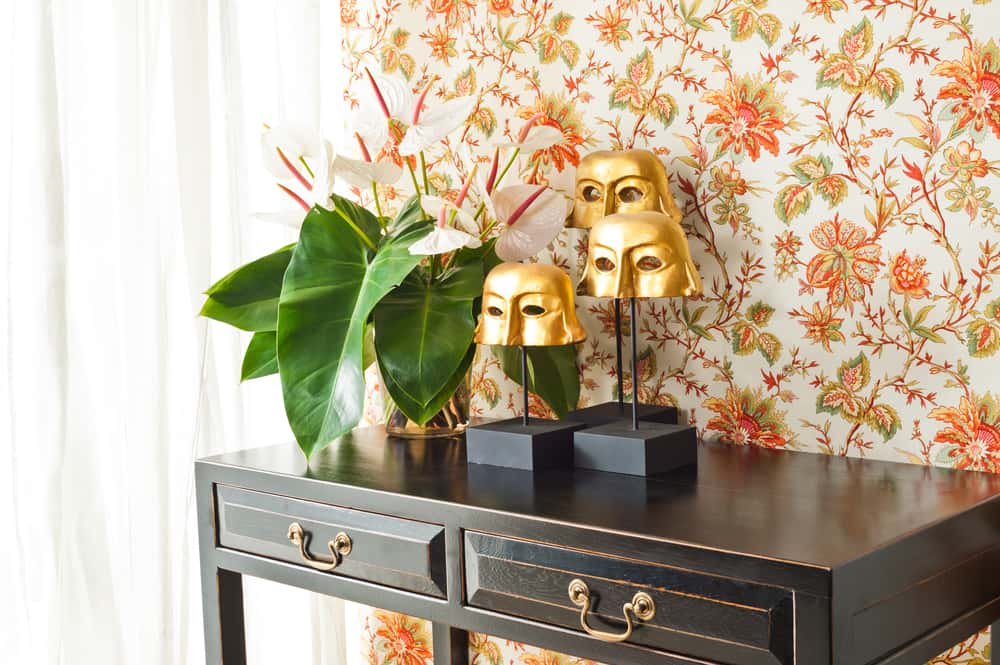What is Chintz?
Chintz (Chint) is a fabric that originated in the 16th century. It is usually a pattern or large florals printed on glazed calico. The word “Chintz” comes from the Hindi “chheent”, which means spray or speckle. (The fabric Calico is named after Calicut).

History of Chintz
Chintz cloth reached the height of its popularity in the 18th and 19th centuries. The most common Chintz pattern was plain weave, but there were a variety of other types. It is still popular as an upholstery fabric.
This is the fabric we think of when we envision grandma’s curtains! It is colourful and floral and can look a bit gaudy. Most modern Chintz fabrics are generally a cotton-polyester blend. This block-printed fabric became popular in Europe after the Portuguese captured parts of India. Soon, Chintz began to be imported en masse to England and France. Since the French mills at the time didn’t know how to produce Chintz, it was banned in 1686.
England soon followed suit, and in 1720, the Parliament of Great Britain enacted a law that forbade the use of imported Chintz in apparel, beds, chairs, cushions, and other household furniture. Finally, in the 1800s, Europeans were able to factory-produce their own Chintz. It remained popular for upholstery because it could be wiped clean easily. The glazed face makes it tough and stain-resistant.

How is Chintz Made?
The historical process of creating Chint fabric was very labour-intensive. Calico cloth was flattened and coated with milk and fruit tannins, which polished the surface and provided a bonding site for natural dyes. The Mughal-style floral pattern was sketched on paper and then traced on cloth with charcoal. The design was brushed with wax wherever blue colour was to be excluded, before dipping the fabric in a vat of indigo dye. The cloth was then dried, and the wax was removed. Madder solutions could turn the indigo into purple or crimson hues. Other colours, such as yellow, were then painted on.
The modern-day process is almost completely mechanised. The fabric is made with combed cotton yarns. It has one polished side and one dull side. This is achieved by applying a fabric stiffener. A padding machine is used to apply the finishing compounds. The fabric is then dried partially and friction calendered. The flower patterns are usually created with press-on block printers.
Over time, the more Indian-looking designs gave way to a Eurocentric aesthetic—so much so that today Chintz is considered essential to British design!

Beyond the Furniture
In the 1700s, working women started using discarded Chintz upholstery material to create dresses. Chintz patterns became so popular that they were adapted into wallpapers and tableware. The floral style is no longer limited to clothing. It can be found everywhere–from graphic design to school stationery.

Resurgence in Modern Design
In 1996, Ikea ran an ad campaign called “chuck out the chintz” in Britain. The idea was to dub Chintz as outdated and ostentatious, and to usher in minimalist-inspired pieces that Ikea is so well known for. It worked—British families bought into Scandinavian chic by the thousands. The result? Soulless beige rooms that all looked the same. However, the pendulum of style has swung again.
Enter grandma chic, the aesthetic of the maximalist millennial. In 2018, Vogue declared that chintz is making a comeback. And it did. (Although it never really exited the Indian market). The Chintz of today is not the ‘80s overstuffed design. Chintz patterns can be used with a discerning eye to give colour and character to a room without crowding every nook and cranny.

How to add Chintz to a Room?
Add a vintage, timeless, colourful accent of Chintz to your room in any of the following ways:
-
Chintz Wallpaper
A bold, floral wallpaper on an accent wall will work very well in an otherwise muted room.

-
Floral Dinnerware
Choose fine bone china in vintage patterns. Give your tea time the charm of an old English novella.

-
A Statement Sofa
A Chintz sofa can be the focal point of your living room. Go all-out on a vintage theme by adding a cuckoo clock or antique vases.

-
Floral Furnishings
Not ready to take the plunge yet? Try a small dose of Chintz by introducing the pattern to cushions or bedsheets. If it makes you happy, add more!

Chintz is a timeless pattern. Chintz patterns come in a variety of styles and designs and can be used for a variety of purposes. They can be used in a modern, elevated manner to add oomph to any space.
A chintz pattern can be just what you need to add some colour and vintage style to your room. Modern Chintz patterns are made with colourfast dyes, so they will not fade away like the patterns from the previous generations. Try adding an element or two of this pattern, or go all in! If you are thinking of giving your home a new look, visit HomeLane for the best design services.





